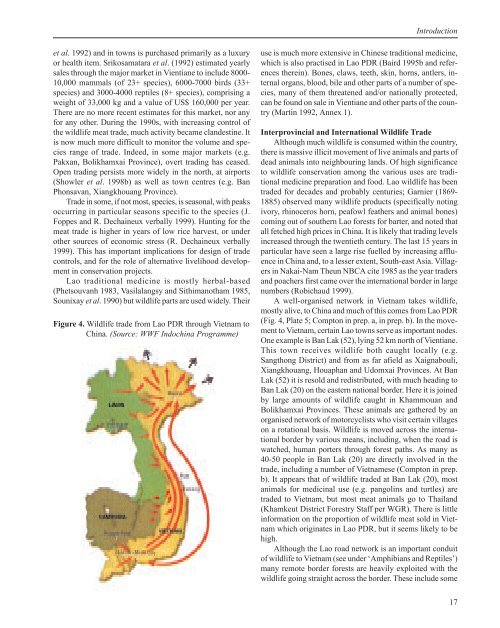Wildlife of Lao PDR: 1999 Status Report - IUCN
Wildlife of Lao PDR: 1999 Status Report - IUCN
Wildlife of Lao PDR: 1999 Status Report - IUCN
You also want an ePaper? Increase the reach of your titles
YUMPU automatically turns print PDFs into web optimized ePapers that Google loves.
et al. 1992) and in towns is purchased primarily as a luxury<br />
or health item. Srikosamatara et al. (1992) estimated yearly<br />
sales through the major market in Vientiane to include 8000-<br />
10,000 mammals (<strong>of</strong> 23+ species), 6000-7000 birds (33+<br />
species) and 3000-4000 reptiles (8+ species), comprising a<br />
weight <strong>of</strong> 33,000 kg and a value <strong>of</strong> US$ 160,000 per year.<br />
There are no more recent estimates for this market, nor any<br />
for any other. During the 1990s, with increasing control <strong>of</strong><br />
the wildlife meat trade, much activity became clandestine. It<br />
is now much more difficult to monitor the volume and species<br />
range <strong>of</strong> trade. Indeed, in some major markets (e.g.<br />
Pakxan, Bolikhamxai Province), overt trading has ceased.<br />
Open trading persists more widely in the north, at airports<br />
(Showler et al. 1998b) as well as town centres (e.g. Ban<br />
Phonsavan, Xiangkhouang Province).<br />
Trade in some, if not most, species, is seasonal, with peaks<br />
occurring in particular seasons specific to the species (J.<br />
Foppes and R. Dechaineux verbally <strong>1999</strong>). Hunting for the<br />
meat trade is higher in years <strong>of</strong> low rice harvest, or under<br />
other sources <strong>of</strong> economic stress (R. Dechaineux verbally<br />
<strong>1999</strong>). This has important implications for design <strong>of</strong> trade<br />
controls, and for the role <strong>of</strong> alternative livelihood development<br />
in conservation projects.<br />
<strong>Lao</strong> traditional medicine is mostly herbal-based<br />
(Phetsouvanh 1983, Vasilalangsy and Sithimanotham 1985,<br />
Sounixay et al. 1990) but wildlife parts are used widely. Their<br />
Figure 4. <strong>Wildlife</strong> trade from <strong>Lao</strong> <strong>PDR</strong> through Vietnam to<br />
China. (Source: WWF Indochina Programme)<br />
Introduction<br />
use is much more extensive in Chinese traditional medicine,<br />
which is also practised in <strong>Lao</strong> <strong>PDR</strong> (Baird 1995b and references<br />
therein). Bones, claws, teeth, skin, horns, antlers, internal<br />
organs, blood, bile and other parts <strong>of</strong> a number <strong>of</strong> species,<br />
many <strong>of</strong> them threatened and/or nationally protected,<br />
can be found on sale in Vientiane and other parts <strong>of</strong> the country<br />
(Martin 1992, Annex 1).<br />
Interprovincial and International <strong>Wildlife</strong> Trade<br />
Although much wildlife is consumed within the country,<br />
there is massive illicit movement <strong>of</strong> live animals and parts <strong>of</strong><br />
dead animals into neighbouring lands. Of high significance<br />
to wildlife conservation among the various uses are traditional<br />
medicine preparation and food. <strong>Lao</strong> wildlife has been<br />
traded for decades and probably centuries; Garnier (1869-<br />
1885) observed many wildlife products (specifically noting<br />
ivory, rhinoceros horn, peafowl feathers and animal bones)<br />
coming out <strong>of</strong> southern <strong>Lao</strong> forests for barter, and noted that<br />
all fetched high prices in China. It is likely that trading levels<br />
increased through the twentieth century. The last 15 years in<br />
particular have seen a large rise fuelled by increasing affluence<br />
in China and, to a lesser extent, South-east Asia. Villagers<br />
in Nakai-Nam Theun NBCA cite 1985 as the year traders<br />
and poachers first came over the international border in large<br />
numbers (Robichaud <strong>1999</strong>).<br />
A well-organised network in Vietnam takes wildlife,<br />
mostly alive, to China and much <strong>of</strong> this comes from <strong>Lao</strong> <strong>PDR</strong><br />
(Fig. 4, Plate 5; Compton in prep. a, in prep. b). In the movement<br />
to Vietnam, certain <strong>Lao</strong> towns serve as important nodes.<br />
One example is Ban Lak (52), lying 52 km north <strong>of</strong> Vientiane.<br />
This town receives wildlife both caught locally (e.g.<br />
Sangthong District) and from as far afield as Xaignabouli,<br />
Xiangkhouang, Houaphan and Udomxai Provinces. At Ban<br />
Lak (52) it is resold and redistributed, with much heading to<br />
Ban Lak (20) on the eastern national border. Here it is joined<br />
by large amounts <strong>of</strong> wildlife caught in Khammouan and<br />
Bolikhamxai Provinces. These animals are gathered by an<br />
organised network <strong>of</strong> motorcyclists who visit certain villages<br />
on a rotational basis. <strong>Wildlife</strong> is moved across the international<br />
border by various means, including, when the road is<br />
watched, human porters through forest paths. As many as<br />
40-50 people in Ban Lak (20) are directly involved in the<br />
trade, including a number <strong>of</strong> Vietnamese (Compton in prep.<br />
b). It appears that <strong>of</strong> wildlife traded at Ban Lak (20), most<br />
animals for medicinal use (e.g. pangolins and turtles) are<br />
traded to Vietnam, but most meat animals go to Thailand<br />
(Khamkeut District Forestry Staff per WGR). There is little<br />
information on the proportion <strong>of</strong> wildlife meat sold in Vietnam<br />
which originates in <strong>Lao</strong> <strong>PDR</strong>, but it seems likely to be<br />
high.<br />
Although the <strong>Lao</strong> road network is an important conduit<br />
<strong>of</strong> wildlife to Vietnam (see under ‘Amphibians and Reptiles’)<br />
many remote border forests are heavily exploited with the<br />
wildlife going straight across the border. These include some<br />
17

















